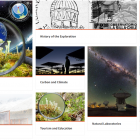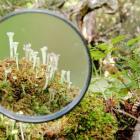Making the Origin of Water and the Cleanest Waters on the Planet Visible
Water is a simple molecule composed of two hydrogen atoms and one oxygen atom. It is a very common compound in the universe, and it is essential for all forms of life on Earth. For this reason, biologists and astronomers converge in their research programs to study and value this precious element. This research is not only fascinating but also pressing in the context of climate change. As stated by the Intergovernmental Panel on Climate Change (IPCC), the water crisis has become a central environmental, social, cultural, economic, and ethical crisis in the twenty-first century. This section guides readers to learn about the unique attributes of freshwater ecosystems and the microcosms inhabiting them in the Cape Horn Biosphere Reserve (CHBR) and about the wonders of the origins of water disclosed by recent explorations of the macrocosm conducted by astronomers based at the Atacama Desert in Chile.
Switch between the microcosm and macrocosm perspectives by clicking on the circles below.
The original virtual exhibition includes the option to switch between the microcosm and macrocosm within the individual chapters (see screenshot below). Here we present the subchapters one after the other.
Underwater Inhabitants in the Rivers of Cape Horn
Water is an essential component for the survival of all beings that live on our planet. The subantarctic Magellanic ecoregion contains the cleanest rainwater in the world, as it is located outside of the air currents that transport pollutants from the Northern Hemisphere. The rivers, lakes, and lagoons of this ecoregion are home to a wide variety of aquatic invertebrates or underwater inhabitants that help maintain the purity of its waters. These organisms inhabit all rivers, streams, and lakes around the world, and include organisms such as arthropods (insects, arachnids, shrimps), mollusks (snails), and worms (freshwater worm and leeches), among others. The great majority live in benthic habitats, such as rocks, sand, or woody debris. Insects, the most diverse and abundant animals on the planet, are one of the most important and least-known members of this group of organisms. Their adaptability and diversity of life forms have allowed them to colonize almost every ecosystem on the planet, from the driest deserts to the Antarctic continent.

Meridialaris chiloensis (Ephemeroptera), an aquatic insect and underwater inhabitant found in the Róbalo River watershed. Photograph by Gonzalo Arriagada Kritzler, n.d.
Meridialaris chiloensis (Ephemeroptera), an aquatic insect and underwater inhabitant found in the Róbalo River watershed. Photograph by Gonzalo Arriagada Kritzler, n.d.
© Fundación Omora. Used by permission.
The copyright holder reserves, or holds for their own use, all the rights provided by copyright law, such as distribution, performance, and creation of derivative works.
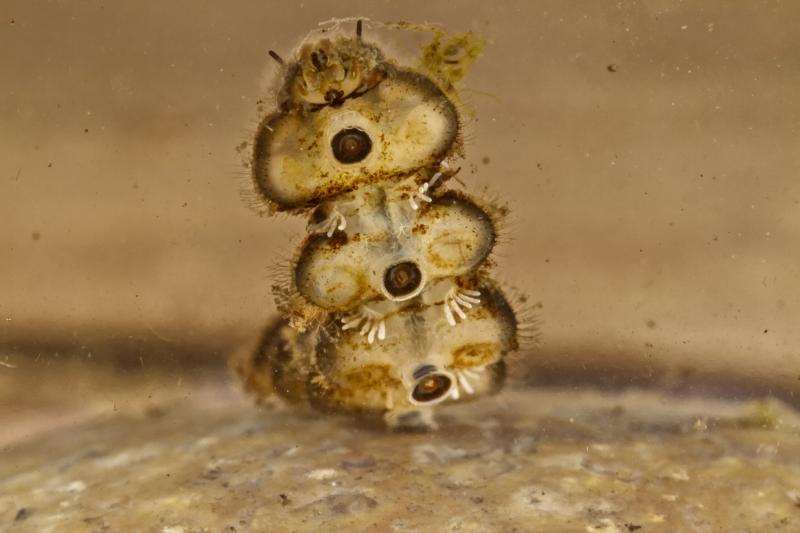
Edwardsina sp. (Diptera), another of the unique inhabitants found along the Róbalo River watershed. Photograph by Gonzalo Arriagada Kritzler, n.d.
Edwardsina sp. (Diptera), another of the unique inhabitants found along the Róbalo River watershed. Photograph by Gonzalo Arriagada Kritzler, n.d.
© Fundación Omora. Used by permission.
The copyright holder reserves, or holds for their own use, all the rights provided by copyright law, such as distribution, performance, and creation of derivative works.
Field Environmental Philosophy (FEP)
We are immersed in a crisis of civilization that entails the rupture of interhuman and interspecies relations. To address this and other social and environmental changes, it is necessary to reconnect global society with biological diversity and cultural diversity, and their interrelationships (in short, biocultural diversity). A first challenge is that biocultural diversity is today, in general, invisible in the fields of education and the concepts of well-being that prevail in our society. For example, despite their impressive diversity and ecosystem relevance, insects are undervalued and rarely considered in conservation efforts, except for those that are medically or economically important. We therefore require methodologies that contribute to making biocultural diversity visible and thus reconnecting it with the globalized world. To achieve this reconnection, Ricardo Rozzi and the Omora Park research team created a novel methodological approach called “Field Environmental Philosophy” (FEP). Participants use methods from sciences, humanities, and arts to not only learn about biocultural diversity, but also propose and practice respectful and responsible ways of coinhabitation.
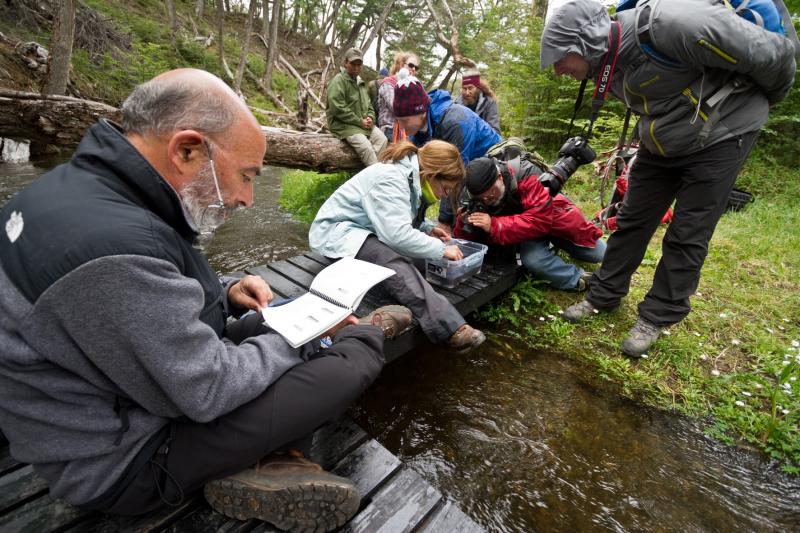
Scholars and students conduct ecological research focused on the biodiversity of freshwater and terrestrial insects and their adaptations to global environmental change along the Róbalo River watershed. Photograph by Gonzalo Arriagada Kritzler, n.d.
Scholars and students conduct ecological research focused on the biodiversity of freshwater and terrestrial insects and their adaptations to global environmental change along the Róbalo River watershed. Photograph by Gonzalo Arriagada Kritzler, n.d.
© Fundación Omora. Used by permission.
The copyright holder reserves, or holds for their own use, all the rights provided by copyright law, such as distribution, performance, and creation of derivative works.
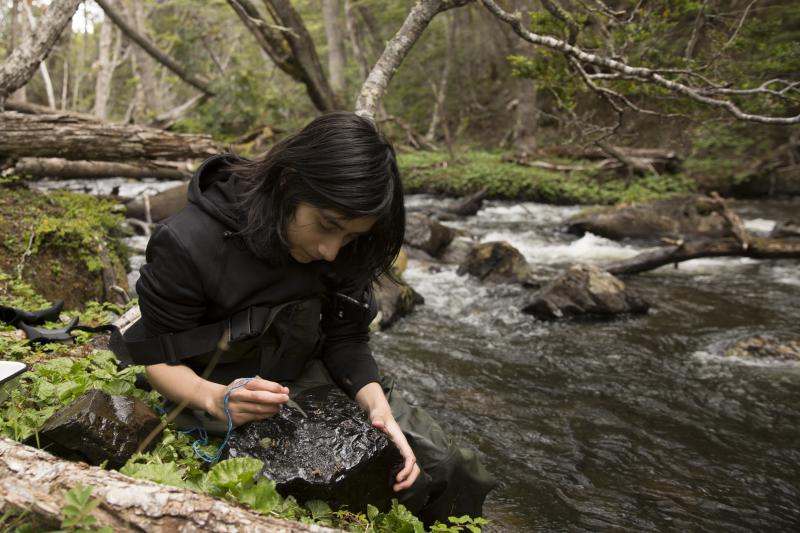
“Underwater with a Hand Lens” at Omora Park. Photograph by Gonzalo Arriagada Kritzler, n.d.
“Underwater with a Hand Lens” at Omora Park. Photograph by Gonzalo Arriagada Kritzler, n.d.
© Fundación Omora. Used by permission.
The copyright holder reserves, or holds for their own use, all the rights provided by copyright law, such as distribution, performance, and creation of derivative works.
In this context, during the last 20 years at Omora Park, researchers have integrated ecological sciences, education, and environmental ethics through the praxis of FEP to contribute to the valuing and conservation of freshwater insects, their habitats, and life habits in the Cape Horn Biosphere Reserve (CHBR). Our ecological work has focused on the adaptations and biodiversity of freshwater and terrestrial insects to global environmental change along the Róbalo River watershed, which provides drinking water to the city of Puerto Williams on Navarino Island. We have discovered, for example, that these organisms can be considered sentinels of climate change, providing early signals of its impacts within these austral ecosystems. At the same time, our philosophical work has focused on contributing to overcoming the conceptual omission of the intrinsic value of freshwater invertebrates, their habits, and habitats, and to recognize and ethically value these organisms. In this context, we designed and implemented an interpretative trail within Omora Park, where we practice the activity “Underwater with a Hand Lens.” Visitors are guided through five interpretive stations, where they can experience direct face-to-face encounters with underwater inhabitants, their habitats, and habits. The praxis of FEP, as it applies to freshwater insects in the CHBR, has allowed us to reach a wide cross section of people and increase awareness and value for these often overlooked organisms. These experiences of direct “face-to-face” encounters have been essential for promoting the valuing, respect, and ethical treatment of these small, beautiful, and crucial coinhabitants. Through the generation of these concrete actions, we aim toward contributing to the transformation of the prevalent ways in which global society understands, values, and relates to freshwater ecosystems and their coinhabitants, fostering more respectful and sustainable life habits in the short and long term.
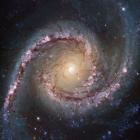
Making the Origin of Water Visible
Water is a simple molecule composed of two hydrogen atoms and one oxygen atom. It is a very common compound in the universe and it is essential for all forms of life on Earth, as it plays a key role in many biochemical processes like photosynthesis or cellular respiration. For this reason, astronomers are focusing on the search for water in Earth’s solar system, other planetary systems, and in the large, distant universe.
The presence of liquid water on planet surfaces is considered key for the development of life as we know it. This has motivated the astronomical community to invest their efforts in the characterization of extrasolar planets in the habitable zone, which is the warm region close to the star where water could be in liquid state.
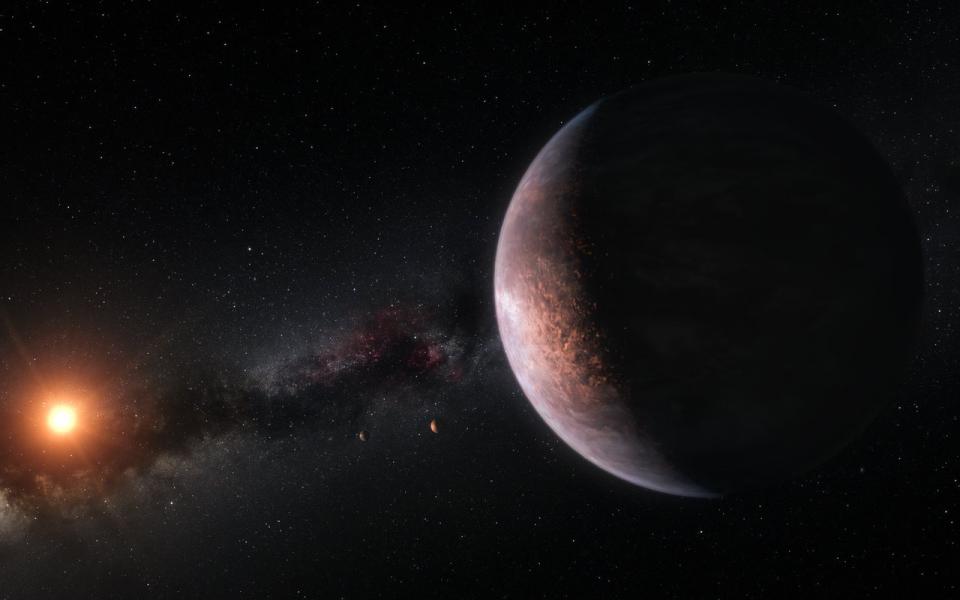
Artist’s impression of the TRAPPIST-1 planetary system. Astronomers believe some of the planets in this system are rich in water.
Artist’s impression of the TRAPPIST-1 planetary system. Astronomers believe some of the planets in this system are rich in water.
Courtesy of ESO/M. Kornmesser.
Click here to view source.
 This work is licensed under a Creative Commons Attribution 4.0 International License.
This work is licensed under a Creative Commons Attribution 4.0 International License.
Water is found in gaseous and ice forms in many solar system bodies like planets, moons, comets, and asteroids. In particular, evidence for the possible presence of liquid water under the frozen surfaces of several moons orbiting the giant planets of Earth’s solar system is inspiring future solar system space missions. Europa and Encedalus, moons orbiting Jupiter and Saturn respectively, have shown evidence of subsurface liquid water oceans. Even if they are far away from the Sun and from the habitable zone, these moons undergo internal heating due to the stretching and flexing they experience in their eccentric orbits around their giant planet, which results in the existence of liquid water below their surface.
The origin of water on Earth is one of the open questions in astronomy. Icy comets and asteroids could be one of the main water suppliers, while part of the water on Earth may have formed in situ during the process of Earth’s formation. Recent studies on the isotope composition of water revealed that the ratio of deuterium to hydrogen in comets is higher than on Earth, suggesting asteroids could be the main suppliers of water on our planet.

These science images show the molecular lines and dust continuum seen in ALMA observations of the pair of early massive galaxies known as SPT0311-58.
These science images show the molecular lines and dust continuum seen in ALMA observations of the pair of early massive galaxies known as SPT0311-58.
Courtesy of ALMA (ESO/NAOJ/NRAO)/S. Dagnello (NRAO).
Click here to view source.
 This work is licensed under a Creative Commons Attribution 3.0 Unported License.
This work is licensed under a Creative Commons Attribution 3.0 Unported License.
Water is not only found in moons and planets, it is also present in the regions where new stars and planets form, around old, evolved dying stars, and in other galaxies, some of them in the distant, early universe. The oldest and most distant evidence of water in the universe was found in the star-forming galaxy SPT0311-58, 12.88 billion light-years from Earth. The discovery was made from Chile, using the Atacama Large Millimeter/submillimeter Array (ALMA), operated by the European Southern Observatory (ESO) together with international partners. ALMA is equipped with a set of receivers that can detect water-molecular transitions emitting at different wavelengths of the millimeter and submillimeter region of the electromagnetic spectrum, and from the faintest and coldest objects in the universe.
The most powerful ground-based telescopes on Earth hosted by Chile, like ALMA, ESO’s Very Large Telescope, and, in the future, ESO’s Extremely Large Telescope, will play a key role in the study of water in the universe and in the characterization of the atmosphere of planets around stars other than Earth’s sun.
Switch between the microcosm and macrocosm perspectives by clicking on the circles above.




